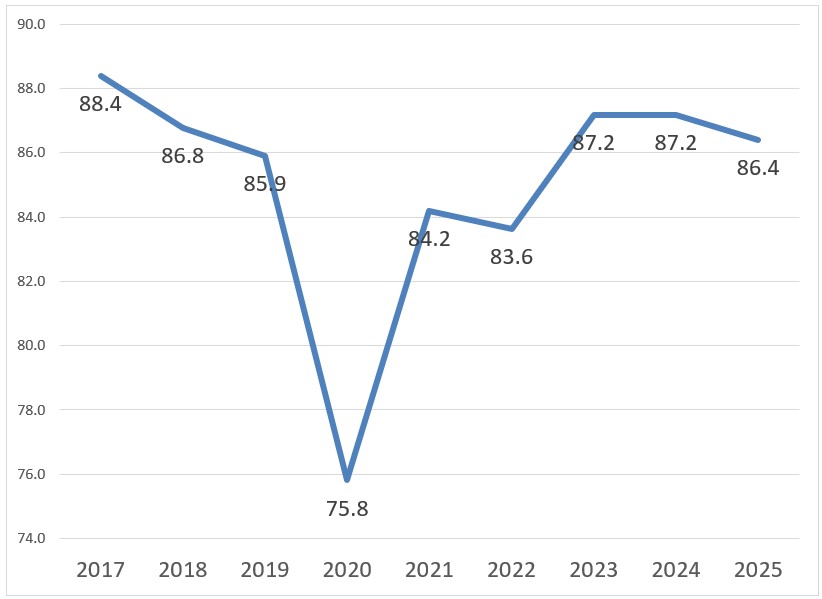Executive Summary:
The Fourth of July is the second most popular American holiday, following only Christmas.
Key highlights include:
- 4% of respondents plan to celebrate the Fourth of July, which is down slightly from last year.
- Average planned spending is $92.44.
- Over 68% of respondents have noticed higher prices, particularly in beverages and food.
- Celebrators are more likely to be male, married, have children, and belong to younger generations (Gen-Z and Millennials).
- July Fourth celebrators report higher overall happiness, particularly in their love life, work life, and government satisfaction.
Stars, Stripes, and Spending: July Fourth by the Numbers
By Dr. Martin Block, Professor Emeritus, Northwestern University, Retail Analytics Council
The Fourth of July is the second most popular American holiday, following only Christmas. Celebrating the Fourth of July is among the topics covered by Prosper Insights & Analytics in its monthly online surveys, which collect data on annual events and related market behavior. Celebrating the Fourth of July was asked in the June 2025 survey (n = 7,880). In response to the question, “How do you plan to celebrate July Fourth this year?” Among all respondents, 86.4% indicated they will celebrate the Fourth. As shown in Table 1, the celebration rate has slightly declined to the 2022 level. The July Fourth holiday is ahead of Mother’s Day.
Table 1. Seasonal Holiday Participation (Percent)
| Percent | |
| Christmas | 93.4 |
| Fourth of July | 86.4 |
| Mother’s Day | 84.2 |
| Celebrate Easter | 80.7 |
| Super Bowl | 76.9 |
| Father’s Day | 75.4 |
| Halloween | 73.1 |
| St. Patrick’s Day | 61.9 |
| Valentines Day | 52.0 |
| Graduation | 33.6 |
Recent Fourth of July Celebration History
The July Fourth celebration rate has remained relatively flat, especially over the last nine years, despite a small drop in 2025, as shown in Figure 1. The rate dropped in 2020, likely due to the impact of the COVID-19 pandemic.
Figure 1. Celebrating the Fourth of July

Celebrating July Fourth is complicated to measure because it involves different activities. Table 2 shows that the most common activity is a cookout at 61.3%, down slightly from 2024. Fireworks follow at 45.3 %. The pattern of celebration activities has changed little since 2024.
Table 2. July Fourth Celebration Activities (Percent)
| 2024 | 2025 | |
| Cookout/Barbecue/Picnic | 66.3 | 61.3 |
| Fireworks/Community celebration | 44.2 | 45.3 |
| Attending a parade | 12.9 | 13.1 |
| Travel/vacation | 12.5 | 11.7 |
| Will Celebrate | 87.2 | 86.4 |
The overall average planned spend is $89.49, up slightly from the 2024 level of $87.53. This compares to $199 for Father’s Day reported last month and the $259 reported for Mother’s Day two months ago. The spending growth has been steady over the previous nine years, with an average annual increase of $2.76 per year. Respondents own a significant amount of patriotic merchandise, as shown in Table 3. The American flag is the leading item, followed by apparel and decorations. Almost a third (29.2%) say they are planning to purchase additional patriotic merchandise within the next 30 days. An additional 30.7% say they are unsure, and 40.1% report no plans for any purchases.
Table 3. Patriotic Items Already Owned (Percent)
| 2025 | |
| American flag | 57.8 |
| Apparel (e.g., t-shirt, hat) | 49.2 |
| Decorations | 38.7 |
| Music | 23.6 |
| Bumper sticker or car decal | 9.3 |
| Other | 2.5 |
| Do not own patriotic merchandise | 17.0 |
Cookouts require a list of items as shown in Table 4. Hamburgers lead the list at 81.8%. Plant-based meat alternatives account for 12.2%.
Table 4: Purchase for Cookout (Percent)
| 2025 | |
| Hamburger | 81.8 |
| Hotdogs/pork or beef brats | 75.1 |
| Chicken | 49.6 |
| Vegetables | 40.7 |
| Plant-based meat alternatives | 12.2 |
| Fish | 11.3 |
| Other | 8.2 |
While the July Fourth menu remains largely centered around typical cookout fare, over half (55.9%) say they are likely to purchase plant-based items, as shown in Table 5. The most common reasons include health concerns (51.3%), guest dietary restrictions (30.8%), and higher prices (50.8%).
Table 5: Purchase Plant-Based Alternatives and Reasons
| Percent | |
| Very likely | 26.7 |
| Somewhat likely | 29.2 |
| Somewhat unlikely | 19.7 |
| Very unlikely | 24.4 |
| Reasons | |
| Health | 51.3 |
| Higher prices | 50.8 |
| Guests with dietary restrictions | 30.8 |
| Climate change | 17.1 |
| Other | 6.2 |
As more Americans celebrate outdoors, sustainability is influencing celebrations. Over half (53.6%) say that they look for recyclable products when buying disposables for events like July Fourth cookouts. This includes recyclables made from recyclable materials and compostable products.
Table 6: When Buying Disposables, What Do You Look For
| Percent | |
| Recyclable | 53.6 |
| Made from recycled materials | 41.2 |
| Compostable | 25.7 |
| Do not purchase these for my celebrations | 20.4 |
July Fourth Celebrators
July Fourth celebrators are described in Table 7, which provides a comparison of the characteristics of celebrators in 2024. To facilitate comparison, an index is computed comparing the percentage of those who don’t celebrate to the total. As shown in Table 7, celebrators are more likely to be male, with those who are not celebrating ranked lower. Those who are married, have children, and are either Gen Z or Millennials are more likely to celebrate the Fourth of July. Those who are divorced or widowed and are a Boomer or Senior are less likely to celebrate. Celebrators also have higher incomes.
Table 7. Celebrator Demographics (Percent)
| Don’t | Celebrate | Total | Don’t Index | |
| Male | 44.2 | 48.6 | 48.0 | 92.1 |
| Female | 55.8 | 51.4 | 52.0 | 107.3 |
| Married | 31.7 | 41.2 | 39.9 | 87.1 |
| Living with an Unmarried Partner | 6.6 | 7.5 | 7.4 | 79.4 |
| Divorced or separated | 15.1 | 10.2 | 10.9 | 138.5 |
| Widowed | 6.5 | 4.7 | 5.0 | 130.0 |
| Single, never married | 37.3 | 33.2 | 33.8 | 110.4 |
| Have Children | 14.7 | 34.3 | 31.7 | 46.4 |
| Income | 56.4 | 67.9 | 66.3 | 85.1 |
| Gen-Z | 12.3 | 19.4 | 18.4 | 66.8 |
| Millennials | 18.4 | 26.1 | 25.1 | 73.3 |
| Gen-X | 28.6 | 29.0 | 28.9 | 99.9 |
| Boomers | 37.1 | 23.7 | 25.5 | 145.5 |
| Seniors | 3.6 | 1.9 | 2.1 | 171.4 |
| Average Age | 53.9 | 47.7 | 48.5 | 110.1 |
| African American | 14.2 | 13.4 | 13.5 | 105.2 |
| Asian | 5.9 | 5.5 | 5.5 | 107.3 |
| Multi-Racial | 1.4 | 1.7 | 1.6 | 87.5 |
| Native American | 1.0 | 1.0 | 1.0 | 100.0 |
| White | 62.2 | 61.2 | 61.4 | 101.3 |
| Hispanic | 11.7 | 14.1 | 13.8 | 84.8 |
| Rural | 20.9 | 23.7 | 23.3 | 89.7 |
| Urban | 40.3 | 40.2 | 40.3 | 100.0 |
| Suburban | 38.3 | 35.5 | 35.8 | 107.0 |
Happiness Levels
Respondents are asked to rate their overall happiness across ten categories on a five-point scale. Table 8 shows the proportion of the combination of “happy” and “totally happy.” The unmistakable conclusion is that those who plan to celebrate the Fourth of July are happier than those who do not, as shown in the composite average. The biggest differences are in love life, work life, and government, as seen in the celebrations of Easter, Mother’s Day, and Father’s Day.
Table 8. Happiness by July Fourth Celebration (Percent)
| Don’t | Celebrate | Total | Don’t Index | |
| Health | 43.2 | 57.6 | 55.6 | 77.7 |
| Family | 51.6 | 67.6 | 65.4 | 78.9 |
| Friends | 50.9 | 64.7 | 62.8 | 81.1 |
| Love Life | 38.1 | 54.6 | 52.4 | 72.7 |
| Home | 53.7 | 66.2 | 64.5 | 83.3 |
| Religion | 45.0 | 59.2 | 57.3 | 78.5 |
| Work Life | 30.2 | 45.4 | 43.3 | 69.7 |
| House | 51.3 | 62.7 | 61.2 | 83.8 |
| Neighborhood | 47.9 | 60.8 | 59.0 | 81.2 |
| Government | 13.7 | 28.8 | 26.8 | 51.1 |
| Composite | 42.6 | 56.8 | 54.8 | 77.6 |
Summary
The Fourth of July ranks only behind Christmas in celebrating frequency. Celebrating the day has remained relatively unchanged over the last eight years. Spending has increased, no doubt because of the emphasis on a cookout and food. The presence of children, age, marital status, and income are the strongest predictors of planning to celebrate. Celebrators are also happier than those who don’t plan to celebrate.
